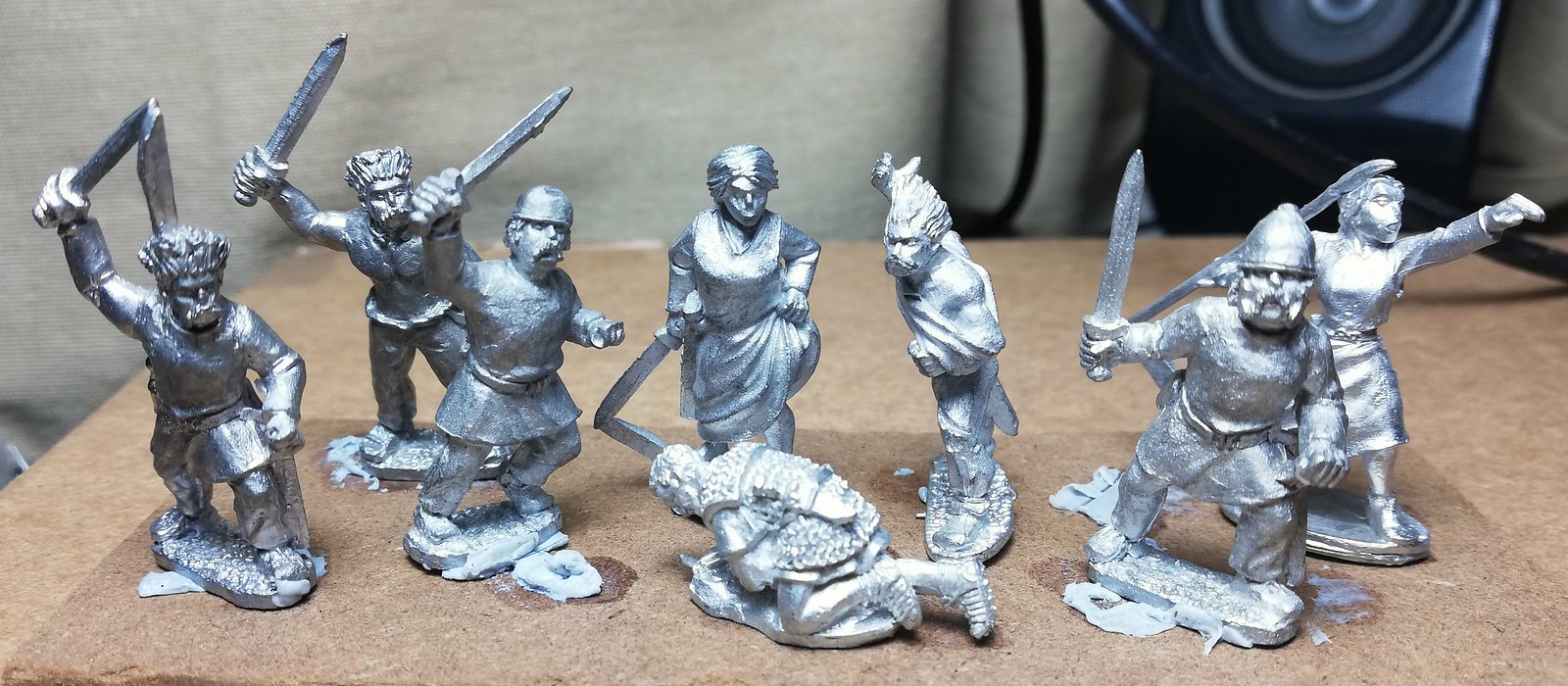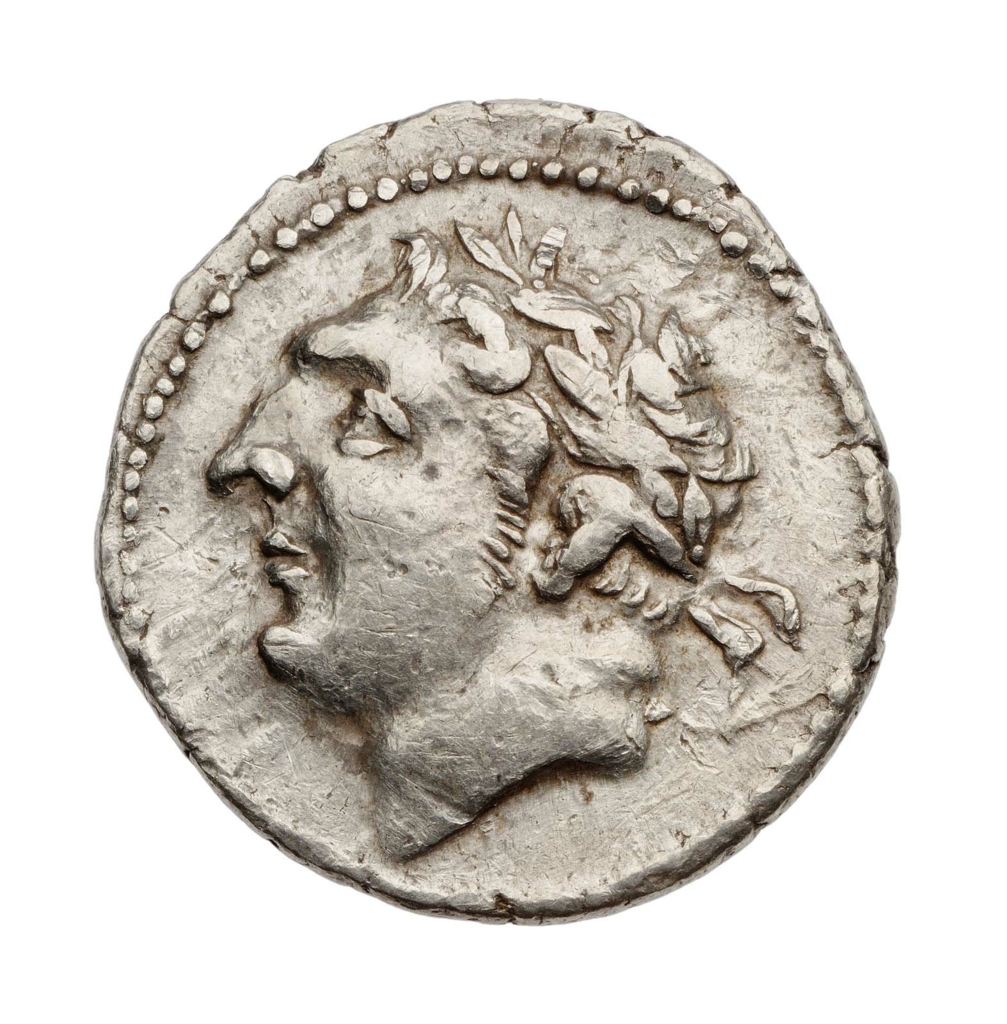I posted a
review of Victrix's
Warriors of Carthage plastic set a while back and shared it on
TMP. User
McWong73 from TMP expressed interest in seeing some comparison shots with Carthaginian models from Crusader Miniatures and Armorum & Aquila (A&A).
I purchased these 28mm metal figures to act as command units, generals and cavalry for plastic Libyans from Victrix.
Here they are.
Infantry Command
The Carthaginian ranges from A&A and Crusader are both by the same sculptor, Marc Sims, so the similarities aren't surprising. However, there are a number of differences.
Let's cover the similarities first. The overall look of the models are similar, crisp and well-sculpted, and the equipment follows a Hellenistic theme. The latter influence also seems to stem from the sculptor's reuse of the maquette developed for A&A's Macedonian phalangite range.
The models all have a forward lean that only seems to make sense with the posture of advancing pike (Crusader's Macedonians stand upright).
 |
| A&A's advancing pike Macedonians |
My suspicions appear to be confirmed by the presence of a
telamon (shield strap) on all the Carthaginian infantry despite them being equipped with a hoplite shield. The
telamon was used on the smaller Macedonian phalangite's
pelte shield to leave the left hand free to support the weight of the long pike. This wasn't needed in the hoplite's armament because the combination of the bowl-shaped shield resting on the shoulder and the counter-weighted long spear allowed single-handed thrusts.
In any case, the presence of a
telamon on infantry carrying a big hoplite
aspis isn't a deal breaker. The shield will cover most of the torso. Plus, we have no exact idea of how Carthaginian infantry looked in full battle dress, though I think it most likely that the
telamon wouldn't be present as evidence such as the Chemtou memorial points towards the use of
aspides or
scuta.
Differences
Similarities aside, the A&A figures are 1-2mm shorter than the Crusader ones. Their forward leaning posture also makes them shorter than the Victrix figures, though they are close in length when compared heel to crown. The first picture above shows a Victrix Iberian standard bearer for comparison on the far right since he has a similar gradient of forward lean as the Sims models. He's still a touch taller.
The A&A and Crusader command do look a little short next to the Victrix Libyan spearmen, but the Carthaginians - who formed the officer class in the army - were reputedly short of stature, though I don't know if this was true in relation to their Libyan subjects.
In any case, a different look for the officers and spearmen is fine, especially if one wants to play up ethnic differences in the Carthaginian army.
There are also differences in the casting quality and metal of A&A compared to Crusader. Crusader has fairly sturdy metal, enough to withstand casual pressure but softer than that used by Aventine or Foundry.
The metal used for A&A is pretty soft. The weapons and helmet feathers (on their Samnite range, for example) tend to bend easily, if not break off altogether. This is exacerbated by A&A's choice to ship their miniatures with as many product codes as possible mixed and stuffed into a ziplock bag and mailed in a soft envelope or lumpy card parcel. Crusader figures come packed by product code in foam and clamshells.
Compared to what I've read from other customers I've been fairly fortunate, but I still received my A&A Carthaginian cavalry command with the fragile left feet missing from three models and hanging by a thread on a fourth.
 |
| I know the Carthaginians practiced cruxifixction, but amputation? |
More careful packaging would help resolve this, as would better quality control on the metal which was quite porous and brittle for my first batch from A&A, with some holes in some models and a fair bit of rough venting, suggesting a torn mould.
That said, A&A are friendly and are more than willing to send replacements if there's a complaint. It's just that they would save themselves some money and their customers some grief by getting it right in the first place.
I received replacements from A&A for the damaged cavalry as well as for a leader figure that had its nose blunted off. They also forgot to put in the transfers I ordered. However, when the replacements arrived in the second order there were further mess ups in the shields and corresponding transfers. Following another complaint this was redressed but that left A&A more out of pocket and myself less enthusiastic about a repeat purchase.
Perhaps I've been spoiled by the excellent, meticulous and thoughtful service from A&A's Belfast neighbour Aventine Miniatures, but when we place an order we should expect to receive the goods as specified and in good condition.
Carthaginian Liby-Phoenecian Cavalry
I mentioned above the fragility of the A&A horsemen's feet. The replacements I received seemed somewhat studier, perhaps a better mix of metal was used, but I'm not chancing a test. One peculiarity of the A&A Carthaginian horsemen sculpts is that the right leg is longer than the left, as can be seen in the photo above. It's not just that the right foot is angled down while the left foot is level, the bottom of the leg greave is uneven.
This asymmetry has been fixed in the Crusader sculpts on the right. But as you can see from the unit shot below it isn't really noticeable once the figures are mounted up. As with the infantry, the Crusader cavalry are a shade taller. The Crusader horse is also larger and leaner bodied. I believe both are ebob sculpts.
I'm not a fan of the A&A horses. At least two of the sculpts either have a problem with the mould or the metal is not settling properly. The shot above shows the problem.
The rear left leg is hollowed out and the nether regions look like they've been kissed by Nurgle. There's a fair bit of awkward filing and greenstuffing to be done here.
The regular A&A horsemen are uncloaked whilst the commands of both lines and the regular horsemen of the Crusader range all have cloaks. This can be helpful if you want to designate one unit as guard cavalry.
The Crusader command has all the usual accoutrements we've come to expect in wargaming: leader with sword, musician and standard bearer. The A&A command has an Officer with his hand raised like the English Queen (front left), a leader with a brandished sword, and another command with a hand positioned to hold a vertical standard (left of centre). So, if you want a banner for the A&A cavalry you'll have to supply your own. The Victrix Numidian Cavalry set comes with a streaming Punic-style banner on every sprue, so I expect I will cannibalise one of those should I need it.
Generals
Here the tables are turned somewhat. A&A offers a mounted and standing 'Hannibal and General' set. It's not clear which one is Hannibal but both are very nicely sculpted with good armour details. Their horses are no different to the Liby-Phoenician cavalry.
I did have some of the aforementioned problems with porous metal, rough mould tears and a damaged nose on the central general, but A&A kindly sent a replacement. The standing centre general is resting a hand on his shield. This hoplite shield is slightly oval rather than round and you will probably need to freehand any decoration on it.
Crusader's Hannibal is rather plain by comparison. He's in an unadorned linen corselet, bearded and unhelmeted. The helmet is a combed Attic helmet that is fairly ubiquitous for model Carthaginians.
The plainness of his supplied mount was too much for me (it's the same as the regular cavalry above) so I asked Aventine to sell me one of the mounts from their 'Pyrrhus and General' set. Reminiscent of Alexander's Bucephalous, it's set to rear with a Hellenistic-style animal pelt for its rider. Keith from Aventine was very happy to oblige.
Given the bullion wealth of the Barcids I rather thought Hannibal would be better kitted out despite his reputation for sleeping rough along with his men. So I may well end up using this model for an earlier Hamilcar Barca should I do the First Punic War or the Truceless War. The beard is a better match to numismatic representations of Hamilcar than Hannibal (who appeared unshaven on Iberian coins, but who knows what a winter trip through the Alps will do to one's grooming?).
My thoughts for the youthful looking A&A generals is to use them as Hasdrubal and Mago Barca. As for Hannibal himself, to my eye the handsomest model on the 28mm market is Relic's and that should be on its way to me.
There's a fancier Mercenary General model from Foundry that could fit with the A&A sculpts. Bearded with plenty of bling, he looks more like a Philip II of Macedon, but he could easily be a later Hamilcar or a later Hannibal at Zama. Foundry and the A&A sculpts appear
very compatible.
On the far right of the photo I've thrown in a figure from A&A's Samnite Command set. This is a really lovely figure that would look great on a command stand with Hannibal. With his pteruges, beard and crested Attic helm he's clearly not meant to be a Samnite. Instead, his triple disc cuirass is a pretty good match for the owner of the Ksour Essef cuirass, an Oscan armour found buried near Carthage.
It's a handsome handsome artifact, so tied into the history that connects Southern Italy to North Africa via Hannibal, and it's lovely to see it represented for the tabletop.
Conclusions
There are pluses and minuses to both A&A and Crusader, though Crusader wins out in terms of figure packaging and metal quality. A&A's post arrived pretty quick and they were open to address specific complaints, although I found myself having to file a complaint with every order. Not fun. I didn't deal with Crusader directly. I got their figures via Caliver Books, which was a tortuous and disheartening process where they forgot to mail the order after a month and it arrived incomplete, and remains so. Next time, I'm going via Northstar.
Aventine and Foundry offer hassle-free service, with Aventine really taking the prize for going the extra mile, no mistakes and being a friendly face. The other companies I've dealt with have a fair way to go. Aventine's horses fit the A&A and Crusader range very well if you care to get replacements or upgrades for leaders.
A&A has some really stand out sculpts, especially the generals and the Ksour Essef warrior. Their other figures blend well with Crusader and offer a wide variety for Carthaginian collectors. You effectively get a double-sized range with more varied sculpts than one normally finds in metal.
While their line infantry are unlikely to mix well in the same unit with Victrix plastics due to height, using their command figures - which is what I've done - works well due to comparable chunkiness. A&A and Crusader also supply one of the few options for Carthaginian cavalry that match Victrix.
Besides the Carthaginians, I also acquired the Celts from A&A and the Celtiberians from Crusader, but I'll compare them in separate posts with other Celt and Iberian ranges.








































